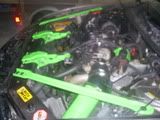I bought new Polk 5 inch speakers for my front doors, and got the adapters at best buy. The guy at best buy told me that I would be unable to use my stock tweeter with the new speakers. He was right. The old speaker had 2 pigtails on it, one for the speaker, and one for the tweeter.
Even though the new speakers have a tweeter in them, Id like the stock tweeters working as well, It sounds like I have all rear speakers now. Is their a pigtail I can buy that can make the aftermarket speaker and stock tweeter work? Or can I just splice the tweeter wire in?












 hogan 3inch DP u bend delete ,180*tstat, autolite 104s, LED interior, 4" FWI, 2000watt system, bullitt rims, zzp pistons, pems, alt rewire, thrush muffs, 3.4 zzp mps, transgo shift kit, triple edge performance trans. autometer triple pod :SOON: urlosn HPT PCM tune, HEADERS, 1.9's
hogan 3inch DP u bend delete ,180*tstat, autolite 104s, LED interior, 4" FWI, 2000watt system, bullitt rims, zzp pistons, pems, alt rewire, thrush muffs, 3.4 zzp mps, transgo shift kit, triple edge performance trans. autometer triple pod :SOON: urlosn HPT PCM tune, HEADERS, 1.9's





 After a while back hooking up some big 6x9's behind the doors I left the stock little window corner tweeters unhooked. Been a few years. Spent an hour or so connecting them back up using the parallel method (solder a speaker wire to appropriate +/- spots on the speaker terminals then run each of the ends of the other side of the wire to the appropriate +/- wires running off the stock tweeter after cutting the line before the special connector). Just make sure to use a 5-6' length of speaker wire then strategically hide it/ tuck it under & behind the door as ur popping the tree fasteners back in before finishing up. It'll make it easier in the future if u ever go to take the door off again. You'll need some length to be able to conveniently remove the door & move it aside with that little tweeter still connceted with the splice you'll have to make about a foot down the wires from the tweeter. I gotta say I didn't think they would make any difference upon analyzing them before connecting them but I stand corrected. They DO add a significant amount of treble to kind of finish off & polish the sound making a solid sound system even better. It's not a HUGE difference but it is DEFINITELY worth the effort & research.
After a while back hooking up some big 6x9's behind the doors I left the stock little window corner tweeters unhooked. Been a few years. Spent an hour or so connecting them back up using the parallel method (solder a speaker wire to appropriate +/- spots on the speaker terminals then run each of the ends of the other side of the wire to the appropriate +/- wires running off the stock tweeter after cutting the line before the special connector). Just make sure to use a 5-6' length of speaker wire then strategically hide it/ tuck it under & behind the door as ur popping the tree fasteners back in before finishing up. It'll make it easier in the future if u ever go to take the door off again. You'll need some length to be able to conveniently remove the door & move it aside with that little tweeter still connceted with the splice you'll have to make about a foot down the wires from the tweeter. I gotta say I didn't think they would make any difference upon analyzing them before connecting them but I stand corrected. They DO add a significant amount of treble to kind of finish off & polish the sound making a solid sound system even better. It's not a HUGE difference but it is DEFINITELY worth the effort & research.




